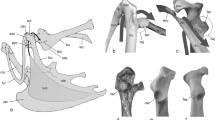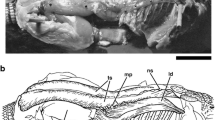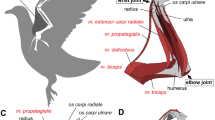Abstract
Reconstruction of the soft tissues (i.e., collateral ligaments, Lig. anticum, menisci, tendon of the M. fibularis brevis) involved in the mechanism of intertarsal joint stabilization in two species of extinct birds, Hesperornis regalis and Emeus crassus, allowed insights into their locomotion. The foot-propelled diving of Hesperornis included loon-like movement of the tarsometatarsus and grebe-like movement of the toes. Movement of the tarsometatarsus in Emeus was restricted to the parasagittal plane, thus resembling those of other Ratites and most highly cursorial birds.





Similar content being viewed by others
Notes
The description is fully applicable to an other member of Dinornithiformes, Dinornis robustus (Zinoviev 2013a).
References
Baumel JJ, King AS, Breazile JE, Evans HE, Vanden Berge JC (eds) (1993) Nomina anatomica Avium II. Nuttal Ornithol Club Publ, Cambridge
Belon P (1555) L’histoire de la nature des oyseavx, avec leurs descriptions, &naïfs portraicts retirez du naturel: escrite en sept livres. Corrozet, Paris
Berman SL (1984) The hindlimb musculature of the white-fronted Amazon (Amazona albifrons, Psittaciformes). Auk 101:74–92
Berman SL, Raikow RJ (1982) The hindlimb musculature of the mousebirds (Coliiformes). Auk 99:41–57
Coughtrey M (1874) Anatomical notes on the Moa’s leg found at Knobby ranges in the province of Otago. Trans Proc R Soc New Zeal 7:269–273
George JC, Berger AJ (1966) Avian myology. Academic Press, New York
Hudson GE (1937) Studies on the muscles of the pelvic appendage in birds. Am Midl Nat 18:1–108
Marsh OC (1880) Odontornithes, a monograph on the extinct toothed birds of North America. Rep US Geol Explor Fortieth Paral 7:1–201
Moreno E (1990) Form and function of the fibularis brevis muscle in some passerine birds. Ann Zool Fenn 27:3–9
Stolpe M (1932) Physiologisch-anatomische Untersuchungen über die hintere Extremität der Vögel. J Ornithol 80:161–247. doi:10.1007/BF01908701
Stolpe M (1935) Colymbus, Hesperornis, Podiceps: ein Vergleich ihrer hinteren Extremität. J Ornithol 83:115–128. doi:10.1007/BF01908745
Zinoviev AV (2000) Function of m. fibularis brevis in birds and mechanism of stabilizing intertarsal joint. Zool Zh 79:1337–1343 (in Russian, English abstract)
Zinoviev AV (2009) Notes on hindlimb myology and syndesmology of Hesperornis regalis (Aves: Hesperornithiformes). J Vertebr Paleontol 29:207A. doi:10.1080/02724634.2009.10411818
Zinoviev AV (2010) Comparative anatomy, structural modifications and adaptive evolution of avian apparatus of bipedal locomotion. KMK Scientific Press Ltd, Moscow
Zinoviev AV (2011) Notes on the hindlimb myology and syndesmology of the Mesozoic toothed bird Hesperornis regalis (Aves: Hesperornithiformes). J Syst Palaeontol 9:65–84. doi:10.1080/14772019.2010.512615
Zinoviev AV (2013a) Notes on pelvic and hindlimb myology and syndesmology of Emeus crassus and Dinornis robustus (Aves: Dinornithiformes). In: Göhlich UB, Kroh A (eds) Paleornithological Research 2013. P 8th Intern Meeting Soc Avian Paleontol Evol. Nat Hist Mus Wien, Vienna, pp 253–278
Zinoviev AV (2013b) Notes on pelvic musculature of Emeus crassus and Dinornis robustus (Aves: Dinornithiformes). Paleontol J 47:1245–1251. doi:10.1134/S003103011311018X
Zinoviev AV (2014a) Peculiarities of deep dorsal thigh muscles in moa (Aves, Dinornithiformes). Ornithol Sci 13:S38-4
Zinoviev AV (2014b) Preliminary observations on hindlimb myology and syndesmology of the Dodo (Raphus cucullatus, Columbiformes). In: Delfino M, Carnevale G, Pavia M (eds) Abstract book and field guide, XII Annu Meet Eur Ass Vertebr Palaeontol. EAVP, Torino, p 159
Zinoviev AV, Dzerzhinsky FJ (2000) Some general notes on the avian hindlimb biomechanics. Bull Moscow Soc Nat. Biol Ser 105:10–17 (in Russian, English abstract)
Acknowledgments
I am grateful to Oliver Hampe (Natural History Museum, Humboldt University of Berlin) for access to specimens and a comfortable research environment. I would like to thank two anonymous reviewers for their helpful and constructive comments that greatly contributed to improving the final version of the article. The research was partially supported by the Deutscher Akademischer Austauschdienst Program “Forschungsaufenthalte für Hochschullehrer und Wissenschaftler.”
Author information
Authors and Affiliations
Corresponding author
Additional information
Communicated by E. Matthysen.
Rights and permissions
About this article
Cite this article
Zinoviev, A.V. Comparative anatomy of the intertarsal joint in extant and fossil birds: inferences for the locomotion of Hesperornis regalis (Hesperornithiformes) and Emeus crassus (Dinornithiformes). J Ornithol 156 (Suppl 1), 317–323 (2015). https://doi.org/10.1007/s10336-015-1195-4
Received:
Revised:
Accepted:
Published:
Issue Date:
DOI: https://doi.org/10.1007/s10336-015-1195-4




